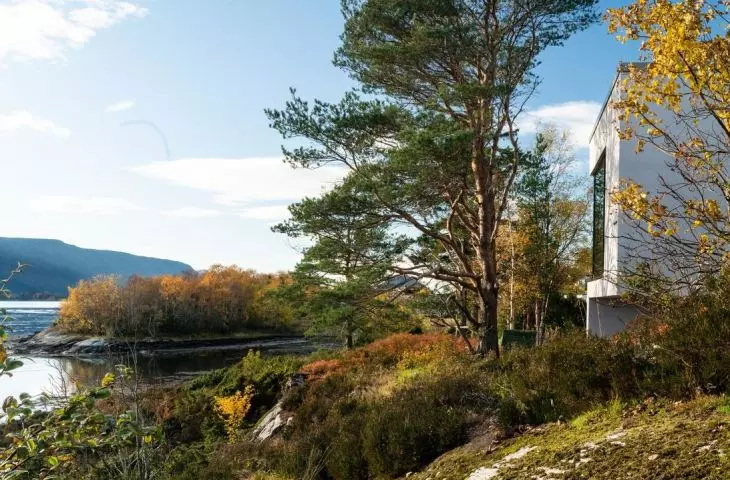A team of Polish architects consisting of: Maksymilian Sawicki, Hanna Sawicka and Kinga Malycha of the Maksymilian Sawicki Arkitektur studio designed a single-family house overlooking the fjords. Located in Ålesund, the building was constructed from functional modules of different heights, creating a cascading layout that corresponds to the terrain.
The house was built on a natural hill
Photo: STUDIO ISTAD © Maksymilian Sawicki Arkitektur
The house was built on the northern coast of the fjord, adjacent to the shoreline. The chosen 750-square-meter plot features a small natural hill covered with lush vegetation and trees, providing protection from the wind, privacy and contact with nature. The architects decided to lower the plot to the road by about 1.5 meters, maximizing views, a sense of privacy and taking advantage of natural light.
The living area offers a panoramic view of the fjords
Photo: STUDIO ISTAD © Maksymilian Sawicki Arkitektur
A considerable challenge was the differences in the height of the terrain. The designers, wanting to integrate the house into its surroundings, used four residential modules and a technical module of different heights, creating a cascading horizontal layout that corresponds to the natural landscape formations. The horizontal emphasis was reinforced by bands of windows and shutters on the north side. Offset forms create overhangs above the building's entrance.
The house was built from modules and has an „L” shape.
© Maksymilian Sawicki Arkitektur
The plan of the house is „L” shaped and has been oriented to the south, towards the fjord, creating a half courtyard and a representative entrance area. The building was constructed using reinforced concrete technology with elements of prestressed construction, allowing the integration of large open spaces and flexible design elements.
The house was built using reinforced concrete technology
Photo: STUDIO ISTAD © Maksymilian Sawicki Arkitektur
interview with Maksymilian Sawicki
Dobrawa Bies: We are talking about a single-family house that was built in Ålesund. Is the design work and implementation in Norway significantly different from that in Poland? What are the challenges?
Maksymilian Sawicki: What distinguishes design in Norway from that in Poland is the different lifestyle that determines the functioning of the house. Opportunities for distant views and maximization of daylight mean that the living zone is designed on the upper floor, while the private zone is usually located in the ground floor. The second important factor is climate. It changes dramatically with geographic location. Wind resistance, snow loads or the resistance class of steel elements are seriously considered at every stage of the project.
Offset forms create overhangs above the building entrance.
© Maksymilian Sawicki Arkitektur
Dobrawa: To integrate the house into the landscape, among other things, you used four modules of different heights. Tell us, please, about the technical solutions you introduced. Did you use special drainage or heating systems?
Maximilian: The idea is to use modules of different heights so as to integrate the house with the environment. They relate directly to the function of the rooms naturally zoning the interior of the building. In the end, we decided to build the house as a reinforced concrete monolith using horizontal and vertical partitions to achieve balance without the need for additional reinforcements in the form of columns. Despite the complex shape, the building became a shell form, ensuring adequate statics. At this stage it became crucial to work with a designer who specializes in prestressed structures. It became important to design the ceilings so that they did not exceed the maximum deflection, which could end up damaging the window ironwork.
The house is divided into zones, with the living area located on the first floor
Photo: STUDIO ISTAD © Maksymilian Sawicki Arkitektur
Dobrawa: And what was the cooperation with the investor like? Did he approach you with a specific idea?
Maksymilian: Cooperation with the investor began much earlier than the implementation of this project. He originally approached us with a request to design a house on another plot of land. After the initial concept was made, it turned out that the plot did not meet all the conditions that the investor wanted, which made us start looking for another location. The actual project had already begun with extensive knowledge of the clients' preferences, which streamlined the design process and strengthened trust on both sides.
The architects took natural light into account when designing
Photo: STUDIO ISTAD © Maksymilian Sawicki Arkitektur
Dobrawa: The interiors of the house are also characterized by minimalistic design, what was your main goal when creating them?
Maksymilian: From the early conceptual stage, we took into account the appearance of the interior. The modular form of the house added character by varying the heights of the different zones. The dining area has a height of 3.15 meters, while the living room is 2.4 meters, which gives a panoramic character with a view of the fjords. Despite the fact that the interiors were not designed by us, the architecture itself made the arrangement much easier for the investors, defining the proportion and functionality of each room.
Dobrawa: Thank you for the interview.




































































